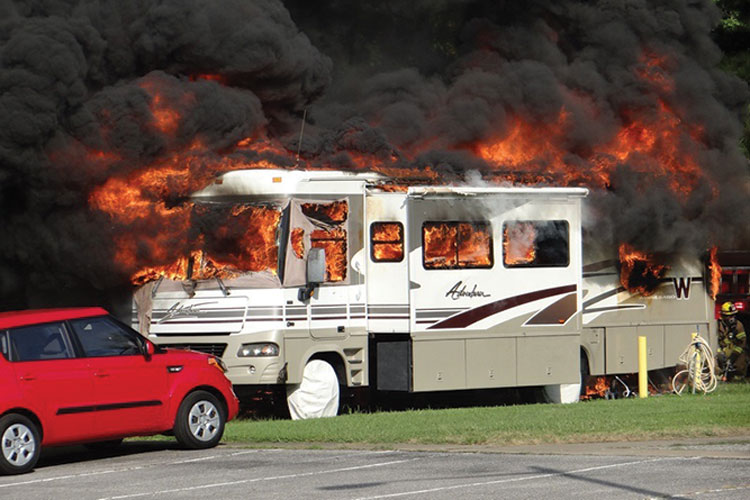
BY MARK WATTERS
The modern day recreational vehicle (RV) offers consumers almost anything imaginable. Prices for these residences on wheels can range from $50,000 to well over $1 million. But do firefighters have any idea of what kinds of dangers RVs present?
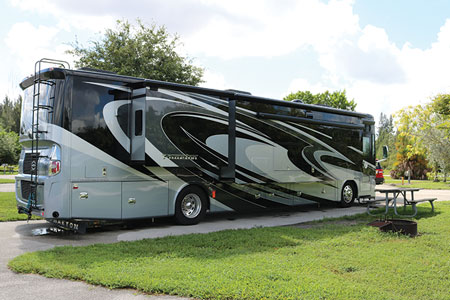 |
| (1) A typical Class A motor home. (Photos by author unless otherwise noted.) |
Our crew was recently transferred to a zone that includes a large county park. Among the many features of it are about 60 campsites for RVs. While doing area familiarization, we observed a large number of high-end motor homes set up at the site. A discussion ensued among my crew as to what would happen if we found ourselves responding to one of these mega-vehicles on fire. The more I researched the question, the more it became apparent how dangerous these vehicles really are. More importantly, I came to realize how unaware we, as firefighters, might be of the seriousness of an RV fire.
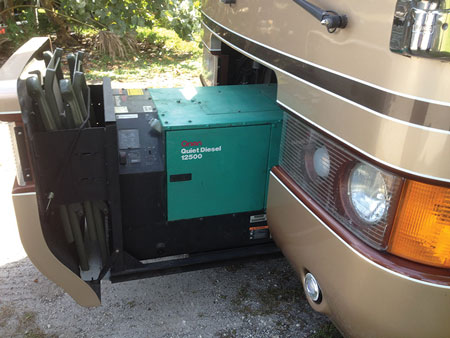 |
| (2) The generator is stored where you expect the motor to be, to keep the noise down in the sleeping areas. |
In 2016, according to the Recreation Vehicle Industry Association (RVIA), RV shipments climbed to 430,961 units, a 15.1-percent increase over the previous year. This was the seventh consecutive annual increase and the fourth double-digit percentage gain in RV shipments since the end of the last recession. Baby Boomers are responsible for most of these sales. With sales increases like this every year, it is likely that your town, city, or county department will be called to this type of fire.
RV Defined
RVs are divided into classes A, B, and C. Class A RVs (the focus of this article) are the largest and are built on a truck frame, like a bus (photo 1). Class C is the middle-of-the-road model, usually built on a van or a pickup truck chassis; it is also called a “cab-over” motor home. The Class B type is a modified van style and is the smallest class.
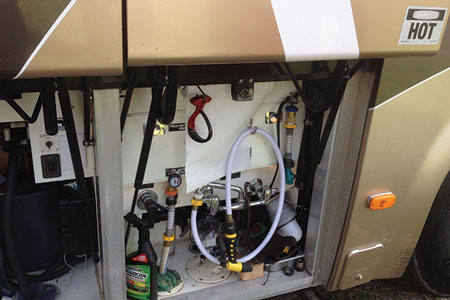 |
| (3) The controls for the tanks containing drinking water and nonpotable wastewater. |
Wood and aluminum are the primary construction materials in RVs, which keep the weight and cost down. Other installed items include several tanks: large gasoline or diesel fuel tanks, depending on the engine type; 40- to 50-gallon holding tanks for gray water (nonpotable); a 50-gallon “black water” (sewage) tank; and a 100-gallon drinking water tank. Additionally, there are miles of wiring, cables, and piping; generator power units; battery backup systems; ammonia cooling units; solar panels; and liquefied petroleum gas cooking/heating units (photos 2-4).
Little Regulation
National Fire Protection Association (NFPA) 1192, Standard on Recreational Vehicles, addresses RVs, covering most of the systems, the emergency exits, and occupant safety. However, despite the NFPA standard, the industry appears to be mostly self-regulated: No single agency oversees manufacturing or safety standards. The RVIA seems to be the central focal point for most RV manufacturers.
Not Your Grandfather’s Car Fire
Firefighters are used to battling the normal vehicle fire with little to no effort once the hoseline is in place and the hood is open. In an RV fire, there is a lot more fuel and toxic material to burn. Thinking the fire can be knocked down using just a tank of water and one preconnect hoseline is a mistake. Instead, tactics may need to include foam, exposure lines, and piercing nozzles. Extinguishers needed include dry chemical and carbon dioxide to handle possible fuel and electrical fires. The ability for engine crews to initiate an attack with Class A foam will make the difference for a quick knockdown and a safer operation overall. My department engine setup and procedures have provided us with this tactical advantage (photo 5).
 |
| (4) This 75-pound LP cylinder supplies all gas appliances and usually has a quick connect or separate 20-pound cylinder for an outside barbecue (arrow). |
Firefighting will include a combination of tactics and techniques used for vehicle, structural, gas, and hazmat incidents. The RV’s wood frame, lightweight construction, and open design allow the fire to travel quickly and to create a very hot, multifuel fire.
Gas Fuel Cylinders
Such fires become even more treacherous when they involve the onboard liquid petroleum gas (LPG) cylinder. I have seen numerous videos of fires involving these vehicles in which the LPG cylinder is venting prior to the fire department’s arrival. The intimidating, freight train-like roar of the LPG cylinder venting can be extremely distracting to firefighters as they exit the apparatus. But there is no time to be mesmerized by the situation. This fire needs to be cooled down quickly and from safe angles to protect the crew.
Knockdown: It’s Not Over Yet
Once the fire has been extinguished and the immediate hazards have been mitigated, the next concern is overhaul. Remember that most of these vehicles carry waste and other hazardous materials. During overhaul, operators must have a high index of suspicion that tanks designed to hold hazardous materials may be damaged and leaking. In addition to tanks containing fuel, LPG, and sewage, the RV may also (depending on the refrigerator system type) have an ammonia unit.
 |
| (5) Typical engine setup for my department: The front line is a prepiped foam system that can flow Class A or B foam. |
In RVs, the refrigeration units may use sodium chromate mixed with ammonia, hydrogen, and water instead of the Freon used in the typical residential refrigerator. The LPG- or electric-powered units cool through a condenser (photo 6) that operates from the top down. The sodium/ammonia and hydrogen gas mixture is heated by an electric element when the unit is hooked up to shore power at the park or by LPG while the unit is on the road. When the mixture is heated, almost like a coffee percolator, the chemical reaction sends the cold gas to the top of the unit and starts its cooling action, ending back down at the bottom of the unit to repeat the process.
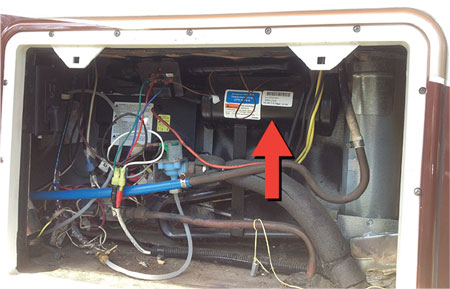 |
| (6) The refrigerant tank (arrow) in an ammonia refrigeration system for a Class A type RV, which was typical before residential-style refrigerators became the standard. |
RV refrigerators are among the most common appliances to catch fire and among the leading causes of RV fires. Recalls were issued for some refrigeration systems because the absorber units were causing fires in the walls of the RV. This led to some interesting fires, showing the typical blue/green flames when the ammonia became involved. The other scenario that leads to fires is a lack of maintenance. RVs are designed to travel great distances at a time and, consequently, they need a great deal of preventive maintenance. The combination of a lack of maintenance and long periods of nonuse can lead to mechanical overheating or wear items freezing. Photo 7 shows an RV in which the heat from the ammonia refrigeration system damaged the side of the RV (arrow). If the refrigeration system is not maintained and checked for leaks, this could lead to a fire.
The Public Perspective
Regardless of the cause of the fire, every firefighter and officer should remember that the public is watching. Several YouTube videos could provoke mixed opinions on how long it took to apply water to the fire and the tactics used.
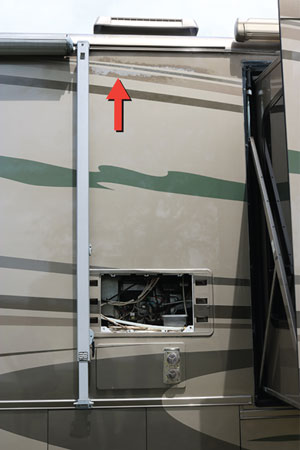 |
| (7) An ammonia refrigerator system showing outside heat damage below the vent (arrow). |
The public expects our firefighters to be well-trained and ready for action, so we need to have a game plan. Don’t wait to get dressed on scene; there is no question that a hoseline must go in service quickly.
 |
| (8) The electric panel for all of the campsites. |
Yes, things are going bad. The scene is chaotic with loud noises and a huge amount of smoke and flames. But, things can’t go well until you get some water on the fire and take away the heat from that LPG tank. Always remember the basics about car fires and working on the highway. Block the lanes you need to operate in, and always stage uphill and upwind of the incident.
At an RV Park
Consider fighting a fire in a RV park where the motor homes or trailers are hooked up to external connections for power, sewer, and water service. In this case, you can kill the power for an entire bank of campsites or for a single one (photos 8-9). Remember, it might be easier and safer to kill the electricity from the feeder panel instead of putting your crew at risk with the individual panel next to the RV. Most of the time, the connections for the utilities, the LPG tanks, and the sewer are on the driver’s side of the RV, so most parks set up their connections for the campsite to accommodate this arrangement.
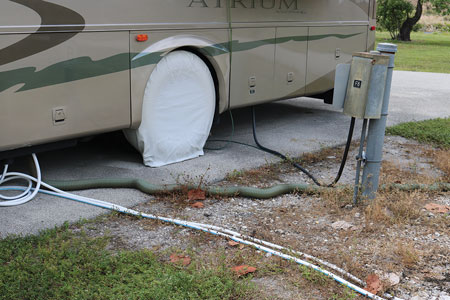 |
| (9) An individual hookup at a campsite. |
Water supply can be an issue in RV parks because of their location. Most RV parks are in rural areas or at least are set up to simulate a rural environment. In the park my department protects, we must obtain our water using tanks or through water shuttles or by drafting. The two fire hydrants in the park are distant from the RV campsites.
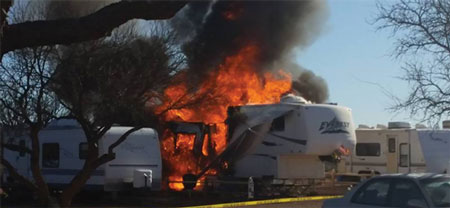 |
| (10) This is a fifth wheel trailer that had a fire involving the kitchen area, most likely the refrigerator. (Photos 10-11 courtesy of Mac the Fire Guy.) |
Campsites and parking areas for trailers and RVs present exposure issues for firefighters. Most times, they will conserve space and locate the vehicles as close together as possible for special events such as NASCAR races. When this occurs, tactics need to change. Remember that, most likely, the involved unit is a total loss and you must focus your attention on exposures.
Controlling the Fuel
Controlling the fuel is the fundamental tactic firefighters use in flammable gas fires. With an LPG tank, tank cooling should be the first priority to prevent a boiling-liquid, expanding-vapor explosion (BLEVE). Most tanks are in compartments, and it will be difficult to get your fire stream directly on them. Knowing the location of the LPG tank for the type of RV will make this process a little easier. For most Class A RVs, the tank is on the driver’s side with the other utilities. After stretching the protection line for the tank, pull additional lines for the exposures and then for the involved unit. Remember, it is damage control at this point.
 |
| (11) A well-involved Class A puller type (motor in front) RV. Note the exposures. |
I hope to raise awareness and stimulate conversation in the firehouse about RVs and the dangers they present to firefighters. Through awareness and training on special hazards like these vehicles, we can hopefully proceed more cautiously and safely with our tactics on extinguishment.
References
- Mac the Fire Guy Web site, http://macthefireguy.com.
- The basic refrigerator cooling system, https://youtu.be/cy1W-uWvR9U.
- An RV fire involving refrigeration system, https://www.youtube.com/watch?v=SyayKbs6ToY.
- Fire after overhaul, https://www.youtube.com/watch?v=3zSjZVlnKHg.
MARK WATTERS is a 32-year veteran of Sunrise (FL) Fire Rescue and a captain in operations. He is the training captain/coordinator for the Plantation (FL) Volunteer Fire Department Training Division. Watters served 16 years as the standards coordinator for the Broward (FL) Fire Academy. He has a bachelor’s degree in organizational leadership from St. Thomas University and an associate degree in fire science.
Recreational Challenges
Large Vehicle Fire Operations
Storage Unit Fires: Hazards Unknown
Fire Engineering Archives

